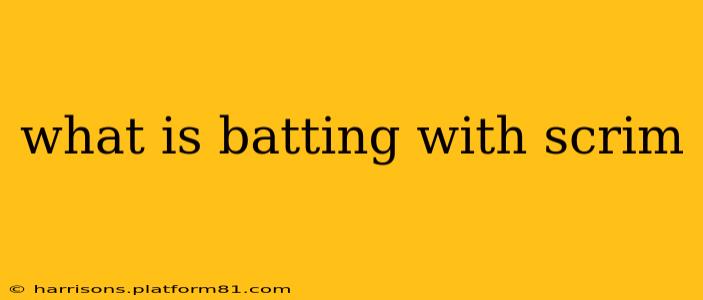What is Batting with Scrim?
Batting with scrim refers to a specific type of batting material used in various applications, primarily in the apparel and crafting industries. It's not simply batting, but a particular kind of batting with unique characteristics. Understanding these characteristics is key to knowing when to use it.
What exactly is scrim? Scrim is a lightweight, open-weave fabric, often made from polyester or other synthetic materials. Think of it as a very thin, almost see-through mesh. Its open structure allows for breathability and flexibility.
So, what does batting with scrim do? When combined with batting, the scrim acts as a reinforcing agent. It adds strength and stability to the softer, fluffier batting material. This prevents the batting from shifting, sagging, or tearing, especially in applications where the finished product will be subjected to stress or frequent use.
Why Choose Batting with Scrim?
Several key benefits distinguish batting with scrim from regular batting:
- Increased Durability: The scrim significantly increases the longevity of the finished product. This is particularly important for items that will be washed frequently, such as quilts or garment interlinings.
- Improved Shape Retention: The scrim's reinforcing action helps maintain the shape of the batting, preventing it from becoming lumpy or misshapen over time. This is crucial for structured items like tote bags or jackets.
- Enhanced Stability: The scrim prevents the batting from bunching or shifting, resulting in a smoother, cleaner finish. This is especially beneficial in quilting where a uniform look is desired.
- Better Drape (in some cases): While adding structure, scrim can surprisingly improve the drape of some fabrics, especially when used in conjunction with flowing outer fabrics.
What are the Different Types of Batting with Scrim?
Several types of batting with scrim exist, differing in weight, fiber content, and overall stiffness. These variations allow for tailoring the batting to specific projects. Some common types include:
- Polyester scrim batting: This is a widely used and cost-effective option, offering a good balance of strength and flexibility.
- Cotton scrim batting: While less common, cotton scrim batting provides a softer, more natural feel. However, it may not be as durable as polyester.
How is Batting with Scrim Used?
Batting with scrim finds its place in a variety of applications:
- Quilting: Provides a stable, durable base for quilts, preventing sagging and ensuring a smooth finish.
- Garment Construction: Used as interfacing or interlining in clothing to add structure and body, especially in jackets, bags, and coats.
- Crafting: Ideal for projects like tote bags, placemats, and other items where durability and shape retention are important.
What are the Alternatives to Batting with Scrim?
While batting with scrim offers many benefits, alternative options exist depending on project needs:
- Regular batting: Suitable for less demanding projects where durability is not a primary concern.
- Fusible interfacing: A stiffer option for creating structured garments, but lacks the softness of batting.
Where can I find Batting with Scrim?
Batting with scrim is usually available at fabric stores, both online and brick-and-mortar, and craft supply retailers. When searching, look for terms like "scrim-reinforced batting" or "stabilized batting."
This comprehensive overview should provide a clear understanding of batting with scrim and its applications. Remember to choose the type of batting that best suits your specific project requirements for optimal results.
